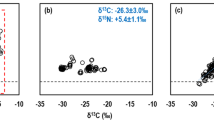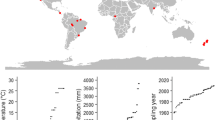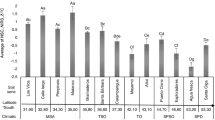Abstract
Background and aims
Although a number of different factors influence C and N isotopic fractionation of organic matter, the δ13C and δ15N values of soil organic matter both tend to increase with soil depth, following similar trajectories. This similarity has not been investigated at the global scale. As microbial decomposition increases organic matter δ13C and δ15N values, soil isotopic values are hypothesized to generally increase with depth across local and global scales.
Methods
Soil δ13C and δ15N values for 16 soil depth-profile sites were used for local-scale investigation, and 5447 global single-depth sites were used for global-scale investigation of the correspondence between δ13C and δ15N. Correlative and boosted regression tree analyses were used to determine the main drivers of the variance in soil δ15N globally and also the environmental association of variability in the correlation with depth between δ13C and δ15N at a number of sites.
Results
Strong positive correlations between δ13C and δ15N values through soil profiles were found at a number of sites and were found to be independent of vegetation type. Globally, soil δ13C and δ15N values were also found to be significantly positively correlated across a wide range of climates and biomes.
Conclusion
The global correspondences between δ13C and δ15N values may suggest a mechanistic link between δ13C and δ15N through the process of SOM decomposition and microbial processing and highlight the importance of soil-related processes in determining isotopic signals in soils. The variability in these soil processes should be considered when interpreting soil isotopic values of δ13C and δ15N as indicators of ecosystem sources of soil C and N and inferring vegetation inputs.






Similar content being viewed by others
References
Ågren GI, Bosatta E, Balesdent J (1996) Isotope discrimination during decomposition of organic matter: a theoretical analysis. Soil Sci Soc Am J 60:1121–1127. https://doi.org/10.2136/sssaj1996.03615995006000040023
Amundson R, Austin AT, Schuur EA, Yoo K, Matzek V, Kendall C, Uebersax A, Brenner D, Baisden WT (2003) Global patterns of the isotopic composition of soil and plant nitrogen. Glob Biogeochem Cycles. https://doi.org/10.1029/2002GB001903
Austin AT, Vitousek PM (1998) Nutrient dynamics on a precipitation gradient in Hawai'i. Oecologia 113(4):519–529
Baisden WT, Amundson R, Brenner DL et al (2002) A multiisotope C and N modeling analysis of soil organic matter turnover and transport as a function of soil depth in a California annual grassland soil chronosequence. Glob Biogeochem Cycles 16:82–1–82–26. https://doi.org/10.1029/2001GB001823
Balesdent J, Girardin C, Mariotti A (1993) Site-related (13) C of tree leaves and soil organic matter in a temperate Forest. Ecology. https://doi.org/10.2307/1941808?ref=search-gateway:4f6368673c42b4f42edf719325fc510e
Benaglia T, Chauveau D, Hunter DR, Young DS (2009) Mixtools: an R package for analyzing finite mixture models. J Stat Softw 32:1–29
Berg B, McClaugherty C (2008) Plant litter. Decomposition, humus formation, carbon sequestration, 2nd Ed. Springer, 2008. Berry JA, Collatz GJ, DeFries RS (2009) ISLSCP II C4 vegetation percentage
Berry JA, Collatz GJ, DeFries RS (2009) ISLSCP II C4 vegetation percentage
Billings SA, Richter DD (2006) Changes in stable isotopic values of soil nitrogen and carbon during 40 years of forest development. Oecologia 148:325–333. https://doi.org/10.1007/s00442-006-0366-7
Boström B, Comstedt D, Ekblad A (2007) Isotope fractionation and 13C enrichment in soil profiles during the decomposition of soil organic matter. Oecologia 153:89–98. https://doi.org/10.1007/s00442-007-0700-8
Cerling TE (1984) The stable isotopic composition of modern soil carbonate and its relationship to climate. Earth Planet Sci Lett 71(2):229–240
Chen Q, Shen C, Sun Y et al (2005) Spatial and temporal distribution of carbon isotopes in soil organic matter at the Dinghushan biosphere reserve, South China. Plant Soil 273:115–128. https://doi.org/10.2307/24125204?ref=no-x-route:bf8f8a632d5dc84e9c9ef56d558d465a
Collatz GJ, Berry JA, Clark JS (1998) Effects of climate and atmospheric CO2 partial pressure on the global distribution of C4 grasses: present, past, and future. Oecologia 114(4):441–454
Cotrufo MF, Wallenstein MD, Boot CM et al (2013) The microbial efficiency-matrix stabilization (MEMS) framework integrates plant litter decomposition with soil organic matter stabilization: do labile plant inputs form stable soil organic matter? Glob Change Biol 19:988–995. https://doi.org/10.1111/gcb.12113
Craine JM, Elmore AJ, Aidar MPM et al (2009) Global patterns of foliar nitrogen isotopes and their relationships with climate, mycorrhizal fungi, foliar nutrient concentrations, and nitrogen availability. New Phytol 183:980–992. https://doi.org/10.1111/j.1469-8137.2009.02917.x
Craine JM, Brookshire ENJ, Cramer MD, Hasselquist NJ, Koba K, Marin-Spiotta E, Wang L (2015a) Ecological interpretations of nitrogen isotope ratios of terrestrial plants and soils. Plant Soil 396(1-2):1-26
Craine JM, Elmore AJ, WANG L et al (2015b) Convergence of soil nitrogen isotopes across global climate gradients. Sci Rep 5:8280–8288. https://doi.org/10.1038/srep08280
Damesin C, Rambal S, Joffre R (1997) Between-tree variations in leaf delta C-13 of Quercus pubescens and Quercus ilex among Mediterranean habitats with different water availability. Oecologia 111:26–35
DeFries RS, Hansen MC, Townshend JR, Janetos AC, Loveland TR (2000) A new global 1-km dataset of percentage tree cover derived from remote sensing. Glob Chang Biol 6(2):247–254
Dijkstra P, Ishizu A, Doucett R et al (2006) 13C and 15N natural abundance of the soil microbial biomass. Soil Biol Biochem 38:3257–3266. https://doi.org/10.1016/j.soilbio.2006.04.005
Dormann CF, Elith J, Bacher S, Buchmann C, Carl G, Carré G, Marquéz JR, Gruber B, Lafourcade B, Leitão PJ, Münkemüller T (2013) Collinearity: a review of methods to deal with it and a simulation study evaluating their performance. Ecography 36(1):27–46
Ehleringer JR, Buchmann N, Flanagan LB (2000) Carbon isotope ratios in belowground carbon cycle processes. Ecol Appl 10:412–422
Eissfeller V, Beyer F, Valtanen K et al (2013) Incorporation of plant carbon and microbial nitrogen into the rhizosphere food web of beech and ash. Soil Biol Biochem 62:76–81. https://doi.org/10.1016/j.soilbio.2013.03.002
Ekblad A, Högberg P (2000) Analysis of δ13C of CO2 distinguishes between microbial respiration of added C4-sucrose and other soil respiration in a C3-ecosystem. Plant Soil 219:197–209. https://doi.org/10.1023/A:1004732430929
Elith J, Leathwick JR, Hastie T (2008) A working guide to boosted regression trees. J Anim Ecology 77:802–813. https://doi.org/10.1111/j.1365-2656.2008.01390.x
Esmeijer-Liu AJ, Kürschner WM, Lotter AF, Verhoeven JT, Goslar T (2012) Stable carbon and nitrogen isotopes in a peat profile are influenced by early stage diagenesis and changes in atmospheric CO2 and N deposition. Water Air Soil Pollut 223(5):2007–2022
February EC, Higgins SI (2010) The distribution of tree and grass roots in savannas in relation to soil nitrogen and water. S Afr J Bot 76(3):517–523
Fernandez I, Mahieu N, Cadisch G (2003) Carbon isotopic fractionation during decomposition of plant materials of different quality. Global Biogeochem Cycles 17:n/a–n/a. https://doi.org/10.1029/2001GB001834
Fischer V, Joseph C, Tieszen LL, Schimel DS (2008) Climate controls on C3 vs. C4 productivity in North American grasslands from carbon isotope composition of soil organic matter. Glob Chang Biol 14(5):1141–1155
Fry, B. (2006). Stable isotope ecology (Vol 521). New York: Springer
Gabet EJ, Reichman OJ, Seabloom EW (2003) The effects of bioturbation on soil processes and sediment transport. Annu Rev Earth Planet Sci 31(1):249–273
Gholz HL, Wedin DA, Smitherman SM et al (2000) Long-term dynamics of pine and hardwood litter in contrasting environments: toward a global model of decomposition. Glob Change Biol 6:751–765. https://doi.org/10.1046/j.1365-2486.2000.00349.x
Gillson L (2015) Evidence of a tipping point in a southern African savanna? Ecol Complex 21:78–86. https://doi.org/10.1016/j.ecocom.2014.12.005
Gillson L, Waldron S, Willis KJ (2004) Interpretation of soil delta(13)C as an indicator of vegetation change in African savannas. J Veg Sci 15:339–350
Grey EF (2011) Some consequences of woody plant encroachment in a mesic South African savanna. Unpublished master’s thesis, University of Cape Town, South Africa
Handley LL, Raven JA (1992) The use of natural abundance of nitrogen isotopes in plant physiology and ecology. Plant, Cell and Environment 15:965–985. https://doi.org/10.1111/j.1365-3040.1992.tb01650.x
Hargreaves GL, Hargreaves GH, Riley JP (1985) Irrigation water requirements for Senegal River Basin. J Irrig Drain Eng -Asce 111:265–275
Hastie T, Friedman J, Tibshirani R (2001) Model assessment and selection. In The elements of statistical learning. Springer, New York, pp 193–224
Hättenschwiler S, Gasser P (2005) Soil animals alter plant litter diversity effects on decomposition. Proc Natl Acad Sci U S A 102(5):1519–1524
Hattersley PW (1982) δ13 values of C4 types in grasses. Funct Plant Biol react-text 479(2):139–154
Heil B, Ludwig B, Flessa H, Beese F (2000) 13C and 15N distributions in three spodic dystric cambisols under beech and spruce. Isot Environ Health Stud 36(1):35–47
Hengl T, de Jesus JM, MacMillan RA et al (2014) SoilGrids1km — global soil information based on automated mapping. PLoS One 9:e105992–e105917. https://doi.org/10.1371/journal.pone.0105992
Hijmans RJ, Van Etten J (2014) Raster: geographic data analysis and modeling. R package version 2.2-31. URL http://CRAN.R-project.org/package=raster. Accessed 15 Mar 2014
Hijmans RJ, van Etten J, Cheng J, Mattiuzzi M, Sumner M, Greenberg JA, Lamigueiro OP, Bevan A, Racine EB, Shortridge A, Hijmans MR (2015) Package ‘raster’. R package
Hobbie EA, Ouimette AP (2009) Controls of nitrogen isotope patterns in soil profiles. Biogeochemistry 95:355–371. https://doi.org/10.1007/s10533-009-9328-6
Hobbie EA, Macko SA, Shugart HH (1999) Insights into nitrogen and carbon dynamics of ectomycorrhizal and saprotrophic fungi from isotopic evidence. Oecologia 118:353–360
Hobbie EA, Macko SA, Williams M (2000) Correlations between foliar δ15N and nitrogen concentrations may indicate plant-mycorrhizal interactions. Oecologia 122(2):273–283
Hogberg P (1997) Tansley review no. 95: 15N natural abundance in soil-plant systems. (erratum: July 1998, v. 139 (3), p. 595.). New Phytol 1–26
Huang Y, Bol R, Harkness DD, Ineson P, Eglinton G (1996) Post-glacial variations in distributions, 13 C and 14 C contents of aliphatic hydrocarbons and bulk organic matter in three types of British acid upland soils. Org Geochem 24(3):273–287
Krull ES, Skjemstad JO (2003) δ 13 C and δ 15 N profiles in 14 C-dated Oxisol and Vertisols as a function of soil chemistry and mineralogy. Geoderma 112(1):1–29
Kuzyakov Y, Domanski G (2000) Carbon input by plants into the soil. Rev J Plant Nutr Soil Sci 163(4):421–431
Kuzyakov Y, Mitusov A, Schneckenberger K (2006) Effect of C3–C4 vegetation change on δ13C and δ15N values of soil organic matter fractions separated by thermal stability. Plant Soil 283:229–238. https://doi.org/10.1007/s11104-006-0015-2
Lang DT, Lang M (2016) Package “RCurl”, R package
Lerch TZ, Nunan N, Dignac MF et al (2011) Variations in microbial isotopic fractionation during soil organic matter decomposition. Biogeochemistry 106:5–21. https://doi.org/10.2307/41490503?ref=no-x-route:12af3dd2e718256c638206e697516b1e
Li Z, Wang X, Zhang R et al (2011) Contrasting diurnal variations in soil organic carbon decomposition and root respiration due to a hysteresis effect with soil temperature in a Gossypium s. (cotton) plantation. Plant Soil 343:347–355. https://doi.org/10.1007/s11104-011-0722-1
Liu J, Wang C, Peng B, Xia Z, Jiang P, Bai E (2017) Effect of nitrogen addition on the variations in the natural abundance of nitrogen isotopes of plant and soil components. Plant Soil 412(1–2):453–464
Lu H, Wu N, Gu Z et al (2004) Distribution of carbon isotope composition of modern soils on the Qinghai-Tibetan plateau. Biogeochemistry 70:273–297. https://doi.org/10.2307/4151469?ref=no-x-route:06baab149dad744f1af8e19b479345cc
Macdonald BCT, Warneke S, Maïson E, McLachlan G, Farrell M (2015) Spatial decoupling of soil nitrogen cycling in an arid chenopod pattern ground. Soil Res 53(1):97–104
Maechler M (2015) Diptest: Hartigan’s dip test statistic for Unimodality—corrected. URL http://CRAN.R-project.org/package=diptest. R package version 0.75-7
Marin-Spiotta E, Smith AP, Atkinson EE, Chaopricha NT (2014) Landscape disturbance history and belowground carbon dynamics. In: AGU fall meeting abstracts 2014 Dec, vol. 1. p L04
Mariotti A, Germon JC, Hubert P et al (1981) Experimental determination of nitrogen kinetic isotope fractionation: some principles; illustration for the denitrification and nitrification processes. Plant Soil 62:413–430. https://doi.org/10.2307/42935413?ref=search-gateway:51f8021df01bde84558143257f594a9b
Ometto JPHB, Ehleringer JR, Domingues TF, Berry JA, Ishida FY, Mazzi E, Higuchi N, Flanagan LB, Nardoto GB, Martinelli LA (2006) The stable carbon and nitrogen isotopic composition of vegetation in tropical forests of the Amazon Basin, Brazil. Nitrogen Cycling in the Americas: Natural and Anthropogenic Influences and Controls. Springer, New York, pp 251–274
Parton W, Silver WL, Burke IC et al (2007) Global-scale similarities in nitrogen release patterns during long-term decomposition. Science 315:361–364. https://doi.org/10.1126/science.1134853
Pataki DE, Billings SA, Naumburg E, Goedhart CM (2008) Water sources and nitrogen relations of grasses and shrubs in phreatophytic communities of the Great Basin desert. J Arid Environ 72:1581–1593. https://doi.org/10.1016/j.jaridenv.2008.03.011
Ponsard S, Arditi R (2000) What can stable isotopes (δ15n and δ13c) tell about the food web of soil macro-invertebrates? Ecology 81(3):852–864
Pries CEH, Schuur EA, Crummer KG (2012) Holocene carbon stocks and carbon accumulation rates altered in soils undergoing permafrost thaw. Ecosystems 15(1):162–173
Qiao Y, Miao S, Silva LC, Horwath WR (2014) Understory species regulate litter decomposition and accumulation of C and N in forest soils: a long-term dual-isotope experiment. For Ecol Manag 329:318–327
Ramankutty N, Foley JA (1998) Characterizing patterns of global land use: an analysis of global croplands data. Glob Biogeochem Cycles 12(4):667–685
Ridgeway G, Southworth MH, RUnit S (2013) Package “gbm”, R package.
Rovira P, Vallejo VR (2002) Labile and recalcitrant pools of carbon and nitrogen in organic matter decomposing at different depths in soil: an acid hydrolysis approach. Geoderma 107(1):109–141
Sikora F J, Moore KP (2014) Soil test methods from the southeastern United States. S. Coop. Ser. Bul, (419). Clemson University, Clemson
Silfer JA, Engel MH, Macko SA (1992) Kinetic fractionation of stable carbon and nitrogen isotopes during peptide bond hydrolysis: experimental evidence and geochemical implications. Chem Geol Isot Geosci section 101:211–221. https://doi.org/10.1016/0009-2541(92)90003-N
Sollins P, Kramer MG, Swanston C et al (2009) Sequential density fractionation across soils of contrasting mineralogy: evidence for both microbial- and mineral-controlled soil organic matter stabilization. Biogeochemistry 96:209–231. https://doi.org/10.1007/s10533-009-9359-z
Swap RJ, Aranibar JN, Dowty PR (2004) Natural abundance of 13C and 15N in C3 and C4 vegetation of southern Africa: patterns and implications. Global change …. https://doi.org/10.1046/j.1529-8817.2003.00702.x
Troughton JH (1979) δ13C as an indicator of carboxylation reactions. In Photosynthesis II. Springer Berlin, Heidelberg, pp 140–149
Trumbore S (2009) Radiocarbon and soil carbon dynamics. Annu Rev Earth Planet Sci 37:47–66
Wallander H, Nilsson LO, Hagerberg D, Rosengren U (2003) Direct estimates of C:N ratios of ectomycorrhizal mycelia collected from Norway spruce forest soils. Soil Biol Biochem 35:997–999. https://doi.org/10.1016/S0038-0717(03)00121-4
Wickham H (2009) ggplot2: elegant graphics for data analysis. Springer Science & Business Media, Berlin
Wilson AT, Grinsted MJ (1977) 12C/13C in cellulose and lignin as palaeothermometers. Nature 265(5590):133–135
Wynn JG, Bird MI, Wong VNL (2005) Rayleigh distillation and the depth profile of 13C/12C ratios of soil organic carbon from soils of disparate texture in iron range National Park, Far North Queensland, Australia. Geochim Cosmochim Acta 69:1961–1973. https://doi.org/10.1016/j.gca.2004.09.003
Wynn JG, Harden JW, Fries TL (2006) Stable carbon isotope depth profiles and soil organic carbon dynamics in the lower Mississippi Basin. Geoderma 131:89–109. https://doi.org/10.1016/j.geoderma.2005.03.005
Zeller B, Brechet C, Maurice JP, Le Tacon F (2007) d^{13}C and d^{15}N isotopic fractionation in trees, soils and fungi in a natural forest stand and a Norway spruce plantation. Ann For Sci 64(4):419–429
Zhang D, Hui D, Luo Y, Zhou G (2008) Rates of litter decomposition in terrestrial ecosystems: global patterns and controlling factors. J Plant Ecol 1:85–93. https://doi.org/10.1093/jpe/rtn002
Acknowledgements
This work was funded by the National Research Foundation (South Africa). We would like to thank Emma Grey, William Bond and Edmund February for providing data for the study.
Author information
Authors and Affiliations
Corresponding author
Additional information
Responsible Editor: Hans Lambers
Electronic supplementary material
ESM 1
Supp. Fig. 1: Observed δ15N against predicted d15N at the global scale based on the global BRT model. Black line indicates the y=x for the observed δ15N values while the red line represents the fitted function for predicted δ15N (y = -0.5x + 1.1). (DOCX 1 mb)
ESM 2
Supp. Fig 2: Test for bimodality of soil δ13C data. Red ribbon represents normal distribution of C4 sites while the blue ribbon represents normal distribution for C3 sites. (DOCX 63.7 kb)
ESM 3
Supp. Fig. 3: Minimum and maximum soil δ13C and δ15N for dominant photosynthetic pathway for all local soil profile sites used in this study. (DOCX 143 kb)
ESM 4
Supp. Fig. 4: The partial dependence of the correlation between δ13C and δ15N on the six most influential environmental predictors. The fitted function represents the modeled relationship between the correlation coefficient of δ13C and δ15N and an environmental predictor once the average effects of all other predictors were accounted for. the Solid line represents the mean of 10 runs of the final, simplified BRT model. Dashed lines represents 27 the 95% CI. A flattening of the line indicates that an increase in the predictor has no further effect on the fitted function. (DOCX 167 kb)
ESM 5
ESM Supp. Fig 5: The partial dependence of δ15N on the six most influential environmental predictors. The fitted function represents the modeled relationship between δ15N and an environmental predictor once the average effects of all other predictors were accounted for. Solid line represents the mean of 10 runs of the final, simplified BRT model. Dashed lines represents the 95% CI. A flattening of the line indicates that an increase in the predictor has no further effect on the fitted function. (DOCX 2.17 mb)
ESM 6
Supp. Table 1. (DOCX 70.9 kb)
ESM 7
Supp. Table 2. (DOCX 39.6 kb)
Rights and permissions
About this article
Cite this article
Nel, J.A., Craine, J.M. & Cramer, M.D. Correspondence between δ13C and δ15N in soils suggests coordinated fractionation processes for soil C and N. Plant Soil 423, 257–271 (2018). https://doi.org/10.1007/s11104-017-3500-x
Received:
Accepted:
Published:
Issue Date:
DOI: https://doi.org/10.1007/s11104-017-3500-x




